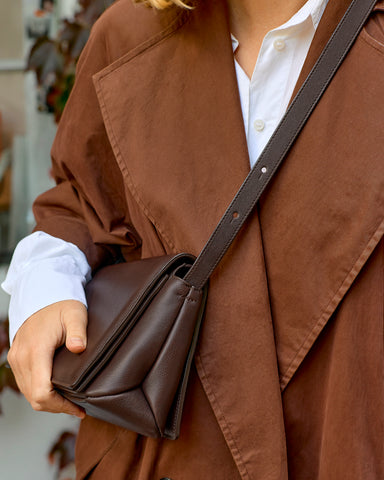in conversation with Lies Mertens about the Lies bag

The lies, a bag that embodies the essence of the brand
Five years ago, Lies embarked on her journey as a designer by transforming her canvas tote bag into an everyday leather bag. Along the way, she refined her craft by listening to the desires of others. When it came to the lies bag, she returned to her own needs and created a bag that embodies the essence of the brand. The lies bag is a testament of her commitment to the combination of functionality and a pure aesthetic.
Where did the inspiration for the lies bag come from?
My inspiration comes mainly from people, their energy, passion and stories. That's why I name my designs after real people. When I was working on the lies bag, I considered my own needs. The inspiration for the design originated while constructing the Ed bag, inspired by graphical shapes, a playful mix between triangles and squares.
The lies bag was designed by you for you. What makes this bag so personal?
I prefer to wear my bags crossbody and relatively short on my body. I had been searching for a crossbody bag to hold more items without causing chaos. The lies bag offers flexibility and organisation because it is divided into three compartments. I always keep my reading book in the back pocket, my mobile phone in the front pocket, and all my other stuff in the middle pocket. The lies bag helps me bring order to the chaos. With the option to add an extra strap, I can wear the bag as a clutch, short under the shoulder, or crossbody.
Finally, the shape is entirely to my liking; I appreciate the refined and graphic design. The front view of the bag is a rectangle, while the side view reveals a triangle. The bag is practical, versatile, and aesthetically entirely in line with my taste.
The creation of the bags starts in your Antwerp atelier. What stages bridge the gap between the idea and the completed bag?
I begin with a mood board and sketches in my atelier. This is a crucial part of the process, as it's where the story begins. From the sketches, we continue to paper prototypes, which often involves a great deal of trial and error. It's not always easy to translate an idea into an actual product. Then, we move on to prototypes from leftover leather. This is then sent to production, along with all paper and digital patterns. The production atelier creates a first prototype using leftover leather, which is then sent to us. After two or three prototypes, we eventually arrive at the final product. In the case of the lies bag, there were five prototypes. Roughly estimating, the process from the initial sketch of the lies bag to the final product took about two years. This is longer than usual, however it shows the challenges that can arise during the design process.
Can you also tell us more about the material of the lies bag in plum?
Transparency and material quality are essential to me. A few years ago, I discovered Vitelco, a Dutch company that manages the entire leather production process in-house, from the farm to the final leather skin. This ensures full traceability and allows us to maintain a short supply chain. Vitelco is located in the North of the Netherlands, making it easily accessible. We regularly have the opportunity to tour their facilities. This level of transparency is of great importance to me.
The next step is sending the hides from the tannery to the production ateliers?
Yes, indeed. In the beginning we only partnered with Venetian Style, an Italian production atelier in Padua. This region is known for its exceptional craftsmanship. At a certain point, we began seeking a second production workshop because we wanted to increase our production capacities. This led us to LSP, a company headquartered in Kortrijk, Belgium with a production atelier in Tunisia. Since LSP's headquarter is in Belgium, the production workshop in Tunisia complies with European regulations. Last year we had the chance to visit their atelier. I find it important to have direct contact with the people making our products.
You're talking about sustainability and craftsmanship. What steps do you want to take in the future?
Transparency and craftsmanship are two things I highly value within the brand. Currently, we already communicate the origins of our raw materials and our finalised products. We are transparent about the production process, especially within the industry in which we operate. In the future, I would like to go further: transparency about our prices, and adding a label so you can precisely trace where the bag comes from. This is a challenge, but we are working on it to hopefully launch this soon.
Learn more about our materials here.
The lies bag is available in-store and online in 8 different colours.







